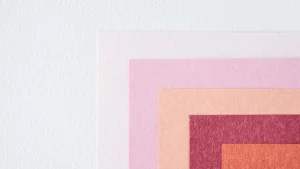At The Printery, every project is handled with care and precision. Our team of seasoned professionals brings decades of experience to the table, ensuring that each print job meets the highest standards of quality.
Aqueous coating is a clear, water-based finish that protects and adds shine to printed materials. You’ll often see it on brochures, postcards, packaging, and other items that need to look professional and hold up well during handling.
If you want your prints to look good and last longer, read on below to see how it’s a smart option to consider.

How Aqueous Coating Differs From Other Types of Coatings
Aqueous coating is different from other print finishes like UV coating, varnish, and lamination in how it’s made, how it’s applied, and how eco-friendly it is.
1. Aqueous Coating vs. UV Coating
UV coating uses chemicals that harden under ultraviolet (UV) light. It creates a very shiny and tough finish, even glossier than aqueous. But UV coating is harder to recycle and sometimes cracks when folded. It also costs more and needs special equipment.
Aqueous coating, on the other hand, is water-based, dries quickly with heat and air, and is easier to recycle.
2. Aqueous Coating vs. Varnish
Varnish is an oil-based or solvent-based coating that works more like ink. It takes longer to dry and offers less protection. It can also yellow over time.
Aqueous coating dries faster, doesn’t smell as strongly, and won’t yellow. It’s also safer for high-speed printing and large batches.
3. Aqueous Coating vs. Lamination
Lamination uses a plastic film that is glued to the paper. It gives strong protection and a smooth feel, but it’s not biodegradable and is harder to recycle. It also costs more and takes longer to apply. Aqueous coating gives a similar look but with less plastic and lower cost.
For instance, a high-end magazine cover might use UV coating for a super glossy look. A luxury product box might use lamination for a thick, plastic feel.
However, if you’re printing brochures for a trade show, aqueous coating gives good protection at a lower price and is better for the environment.
Why Choose Aqueous Coating for Large-Scale Prints
Aqueous coating works by adding a thin, clear layer on top of printed paper to protect it from damage. It helps prevent scratches, scuffs, and smudges. It’s especially useful when your materials are mass-produced and exposed to frequent use or movement.
It also makes your prints look better by enhancing color and adding a smooth or slightly shiny finish, depending on the type you choose. This can make marketing materials feel more polished and professional.
On top of that, aqueous coating dries quickly and has a low odor, which makes it perfect for large-volume jobs. It also helps prevent sheets from curling or sticking, keeping your prints clean and flat during transport.
Here’s how it holds up in several situations:
- Handling: A product catalog at a trade show or showroom stays cleaner and more presentable even after being flipped through by dozens of people.
- Shipping: A box of promotional flyers sent to multiple retail locations arrives in good condition, with prints still sharp and unmarked.
- Display: A printed poster or retail display sign stays resonant and crisp on the wall for weeks, even in high-traffic areas like store entrances or lobbies.
These benefits make aqueous coating a smart and reliable choice when you need your printed materials to look great and hold up, whether they’re on a shelf, in a mailbox, or in someone’s hands.
The Environmental Benefits of Aqueous Coating
We’ve already mentioned that aqueous coating is an eco-friendly choice, but let’s take a closer look at what makes this water-based finish a smarter, greener option.
1. Low VOCs and No Strong Odors
As we’ve said, aqueous coatings are water-based and don’t use solvent chemicals. This means they release far fewer volatile organic compounds (VOCs) compared to solvent-based finishes, keeping indoor air clean during printing.
2. Less Plastic, Only Minimal Polymers
They use about 6 grams of polymer per square meter, much less than plastic liners like PE or PLA, which use 15–30 grams per square meter.1 That means lower plastic use overall.
3. Breaks Down in Compost (With Time)
Aqueous coatings made from biopolymers like starch, chitin, or cellulose can break down in compost over time. A 2023 review published in the Progress in Organic Coatings journal explains that these coatings are both compostable and recyclable, making them better for the environment than traditional plastic finishes.2
4. Lower Carbon and Pollution Footprint
A study showed that water-based coatings have about 50.8% less VOC content than solvent-based coatings on average. The study also indicated that water-based coatings released 44.2% fewer aromatic compounds (harmful chemicals often found in industrial solvents) compared to solvent-based ones.3
5. Safer to Manufacture and Use
Water-based (aqueous) coatings are safer throughout the entire printing process. Because they don’t rely on harsh chemical solvents, workers are less exposed to toxic fumes or skin irritants during production and application. This also means there’s less need for special ventilation or protective gear in print facilities, making the work environment healthier.
Is Aqueous Coating Right for Your Brand?
If you’re printing materials for your business, it’s important to choose the right finish. Aqueous coating is a strong option, but is it the best fit for your next print project?
Here’s how to decide:
- Do your prints get handled a lot? If you’re printing brochures, menus, catalogs, or packaging that people will touch often, aqueous coating helps protect against fingerprints, smudges, and wear.
- Are you printing in large quantities? Aqueous coating is great for big print runs because it dries quickly and keeps costs low. It’s often used for flyers, postcards, and other bulk items.
- Do you want your materials to look more polished? This coating adds a smooth, clean finish that makes colors pop and text easier to read. It can make your prints look more professional and on-brand.
- Is sustainability important to your company? Aqueous coating is water-based and has low chemical emissions, so it’s a more eco-friendly option compared to solvent-based finishes or plastic laminates.
- Are your materials meant to be displayed? If you’re printing posters, signs, or product tags, this coating helps them stay neat and sharp, even after being out in the open for a while.
At The Printery, we can guide you through your options and recommend the right finish based on your brand’s needs, whether you’re printing in bulk, going green, or just want your materials to look their best. Contact us today to get expert advice, request a sample, or start your next custom print order with confidence!

Sources:
- Factsheet: Aqueous lining, a water-based coating | Verive. (2024, January 5). Verive. https://verive.eu/factsheet-aqueous-lining-a-water-based-coating/
- Adibi, A., Trinh, B. M., & Mekonnen, T. H. (2023). Recent progress in sustainable barrier paper coating for food packaging applications. Progress in Organic Coatings, 181, 107566. https://doi.org/10.1016/j.porgcoat.2023.107566
- Xia, S., Zhao, Q., Ji, J., Wu, R., Chen, L., Yin, Y., & Liu, Q. (2023). Impact of Water-Based Coating Substitution on VOCs Emission Characteristics for the Surface-Coating Industries and Policy Effectiveness: A Case Study in Jiangsu Province, China. Atmosphere, 14(4), 662–662. https://doi.org/10.3390/atmos14040662



